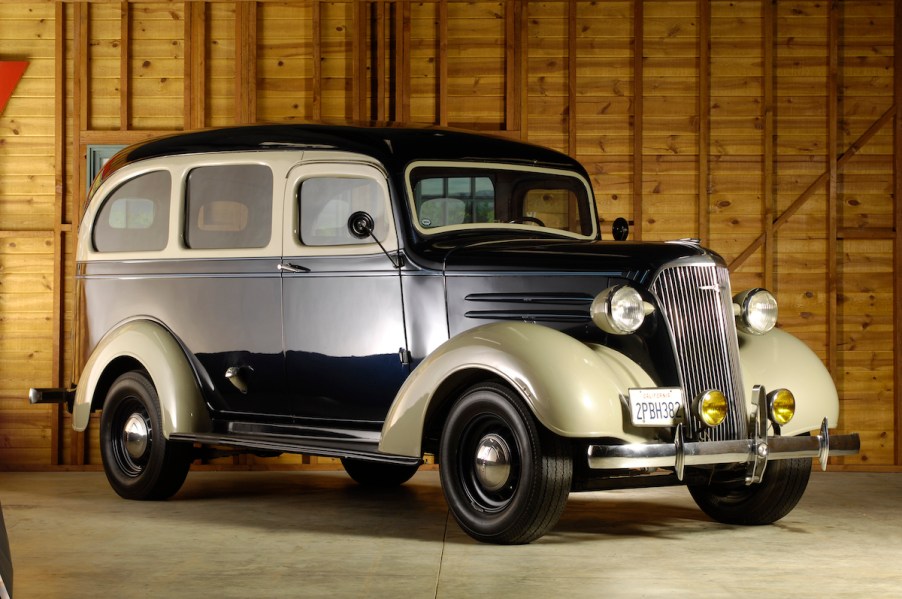
The Chevy Suburban Holds an Unusual Yet Impressive Record
The price for a gallon of gas in 1935 was 19 cents, the average house cost a little more than $4,000, and the sticker price on the average car was $760. Into this world where a dollar went a lot further, Chevrolet introduced their Suburban Carryall with a $675 price tag.
The world has seen many changes since the longest running nameplate in automobile history came into the world and so has the Chevy Suburban, which celebrates an unusual yet impressive record as an American favorite, according to MotorTrend.
The original Suburban Carryall
Built on a half-ton commercial truck chassis, the original suburban featured a steel body with windows all around and three rows of bench seats to accommodate eight. However, the first model only had two doors, just like the commercial truck. Its design evolved from the open topped “delivery sedans” of the 1930s.
It provided a solution to mining operations that needed a way to transport miners to and from the mines. By 1937, its original 60 hp “Stovebolt” inline six engine saw an upgrade to 79 hp to better accommodate the weight and it underwent a streamlined exterior design modification, but it was still, essentially a truck.
Wartime and postwar Suburban
During World War 2, most domestic car and truck production came to a halt, but various models, including the Suburban were pressed into military service. Design changes were on hold during the war, but changes to Chevrolet’s line of trucks also affected the Suburban after the war. In 1950, Chevrolet offered their Suburban with an option bottom and top tailgate style or a barn door style tailgate.
It was during this period that Plymouth took a stab at duplicating the success of the Suburban, introducing their own model in 1952, but it only seated 5 passengers and disappeared from production by 1962.
Wrap-around windshields and body-flush fender designs that took over Chevy’s late 50s models also applied to the Suburban and factory-installed 4WD was another significant addition in 1957. The first three-door design came out in 1967 and the Suburban became a popular choice for ambulances going into the 1970s. It wasn’t until 1973, that Suburban saw the addition of a second door on the driver’s side. That model year also saw power upgrades in the form of a 454 big-block engine as well as the introduction of a three-quarter ton model.
Gas crisis Suburban
The main focus in the late 1970s was on interior design, accommodating Suburban’s use as a family vehicle. It is unlikely that the 454 big-block engine brought on the gas crisis, but Chevrolet never backed down from powering the Suburban even as other companies turned to reducing engine size and fuel consumption. The early 1980s saw various body and interior alterations and the development of automatic locking hubs on 4WD models.
With fuel economy still a concern in the mid 1980s, electronic fuel injection and four-speed overdrive were added to the Suburban to increase efficiency. 1992 models showcased many of the most drastic changes with the option of a small block 5.7L engine on half-ton models, a smoother (carlike) suspension system, four-wheel anti-lock brakes, and Insta-Trac on 4WD models.
21st century Chevy Suburban
Suburban accelerated into the 21st Century with both interior and exterior style changes. Vortec V8 engines in 5.3L and 6.0L options powered the new models throughout the first decade of the new century. Four-wheel disc brakes and load-leveling suspension systems were additional new features introduced in the 2000 model. A wind tunnel-shaped exterior and the elimination of chrome front and rear bumpers were alterations made in 2007 as Chevrolet worked toward greater efficiency, comfort, capability and versatility. Their 2007 and 2008 alterations brought on dark days for this very popular SUV as excessive oil consumption and more than 350 critical issues threatened to destroy America’s love with this long-running SUV.
2020 Suburban
Suburban’s 75th and 85th anniversary celebrations would not be spoiled by prior issues as Chevrolet worked hard to maintain the stellar reputation of history’s longest-running nameplate. 2013 saw the introduction of the eleventh generation of the Suburban and Chevrolet worked hard to keep up with fierce competition from domestic automakers as well as foreign competition from the Toyota Sequoia. True to form, Chevrolet has outlasted the competition with owner satisfaction holding firm as Suburban starts into a new decade.
Muscle and towing capacity are not lacking in the 2020 model, even as its exterior and interior designs keep up with the competition. Safety, especially on rough roads and bad weather, are major advantages of the 2020 model, providing great peace of mind for family-minded drivers. Chevrolet has kept up with automotive infotainment as well, installing an 8.0-inch touchscreen with Apple CarPlay, Android Auto, and a 4G LTE mobile hotspot, five USB ports and five 12-volt outlets, features that were unimaginable in the 1935 Carryall model.
Moving forward with the Chevy Suburban
As Suburban begins its journey toward its 100th anniversary, it is clear that Chevrolet does not intend to go quietly into the night. Building on Suburban’s 85 year foundation, the 2021 model Suburban promises to launch this long-running SUV into a position of prominence among its competitors, promising buyers more than they can handle.
The unusual, yet impressive record of Chevy Suburban from practical utility of the Carryall to the modern versatility of a family vehicle stands firm as an iconic bit of Americana that refuses to pass away. As the world changes, Suburban continues to change with it, meeting the needs of families with dependable, comfortable and powerful transportation.


